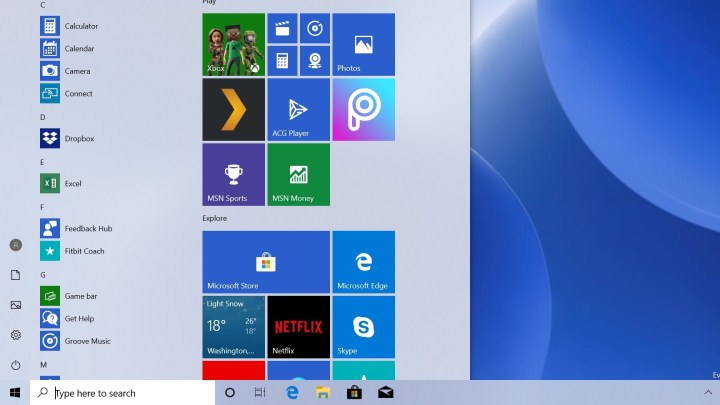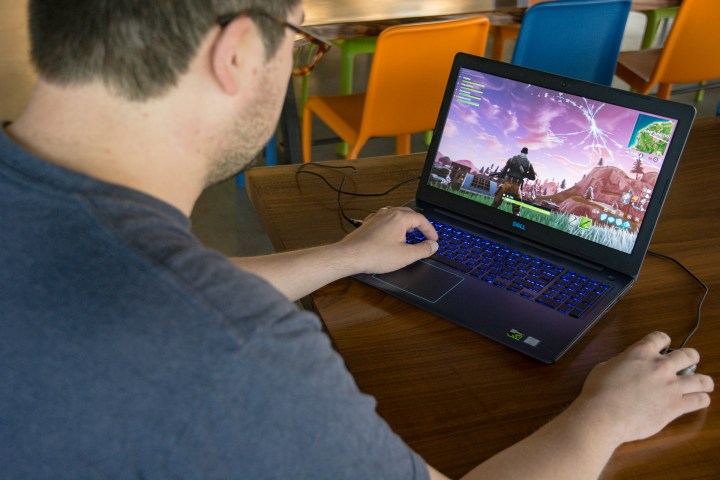Windows 7 has been around for a long time, and it’s one of Microsoft’s most popular operating systems. But its time has now long passed, and Microsoft no longer officially supports it for the general public. It’s essential to move on to something more secure and modern.
If you’re still concerned about the move, though, here are a few ways in which Windows 10 is better than Windows 7.
The look: Start menu and apps

Windows 7 holds on to tradition from previous releases, such as Windows XP and Windows 98, and features a familiar, simplistic, and easy-to-understand user interface. Want to find your program? Hit the Start button and find it on the list. Want to add a printer or visit the control panel quickly? Click the link to the right side of the Start Menu. Aside from a fancy Aero Glass look, there are no distractions that get in your way. All the essential information and settings you typically want are right there, front and center.
Along with changing its colors and further customizing Start menu elements, Windows 10 shakes up things and reintroduces a feature from Windows 8 known as Live Tiles. Some Windows 10 apps can install directly as .exe files and download through the Microsoft Store platform. These apps will have Live Tiles on the right side of the Start menu.
By default, some Live Tiles are pinned next to the list of your desktop apps and intend to show you quick information about weather, sports, and more at a glance. Windows 10’s Start menu and Live Tiles are also heavily optimized for newer touchscreen devices, and Microsoft is planning some improvements for the experience.
Like the App Store on your iPhone, you can download Instagram, Twitter, Facebook, Netflix, and more to your PC from the Microsoft Store. These make accessing some of those popular services quicker and easier, and the overall UI is a bit more optimized for newer touchscreen devices. That’s something Windows 7 can’t do at all.
The features: Notifications, search, and Cortana

Also slightly similar to your iPad, Windows 10 has a dedicated notification center known as the Action Center. If you’re on Windows 7, notifications typically appear in the taskbar, but Windows 10 steps that up and puts notifications in one clean and concise environment. The Action Center in Windows 10 will show notifications about important system information and emails. It also has quick toggle switches for screen brightness, sharing files, network settings, and more.
Another significant difference between Windows 7 and Windows 10 is the addition of Cortana. This Windows 10 voice assistant is more or less equal to Apple’s Siri and can assist you in specific tasks like keeping up with sports scores, weather, and sending emails. Cortana is a big part of the newest version of Windows and comes integrated with several core areas, including the Microsoft Edge web browser, exclusive to Windows 10. That web browser is also more modern than Internet Explorer 11, which was bundled in Windows 7. It comes with support for ad-blocking extensions, continuing web pages from your phone, and more.
As for searching for your files, Microsoft is separating Cortana from search in the current of Windows 10. This makes the search experience in Windows 10 more like Windows 7, but with the bonus of having it search the internet and the web for helpful information, along with your files.
Support and security

As mentioned above, Microsoft has officially ended support for Windows 7. That means that upgrading Windows 10 is your best bet to stay safe from the ever-evolving threats from viruses. However, unlike Windows 7, which only received one major Service Pack update, Microsoft frequently works on significant updates to Windows 10. Additional features are always making their way into the newer Windows OS. It gets major updates twice a year, and in the past few years, Windows 10 has received extra features, like the ability to sync your activities across devices with Windows Timeline.
Unlike previous versions (including Windows 7), Windows 10 isn’t a stand-alone product for Microsoft. It’s more like a service. The company releases updates twice a year and intends to keep supporting the OS shortly. If that plan works out, that means you shouldn’t need to buy a new version a few years from now. The Windows 10 October 2020 update brought features including the ability to pin websites to the taskbar, removed the need for passwords using Microsoft accounts, modified text and cursors for easier visibility, added the ability to quickly create events, and more. The Spring 2021 update is anticipated to arrive in May and will include updated settings pages, tweaks to the search box and Cortana settings, and new icons. There are also work-from-home improvements, like Windows Management Instrumentation (WMI) Group Policy Service (GPSVC) updates, multi-camera support for Windows Hello users to select external cameras in integrated displays, and optimized document-opening scenario times for Windows Defender Application Guard.
Compatibility and gaming

Despite all the extra features in Windows 10, Windows 7 still has better app compatibility. While Photoshop, Google Chrome, and other popular applications continue to work on both Windows 10 and Windows 7, some old third-party pieces of software work better on the older OS. That can include software for printing mailing labels, managing point-of-sale systems, and more. This is often a reason some businesses have been reluctant to update.
Still, Microsoft is taking steps to kill off compatibility in Windows 7. As an example, Office 2019 software won’t work on Windows 7, nor will Office 2020. There’s also the hardware element, as Windows 7 runs better on older hardware, which the resource-heavy Windows 10 might struggle with. In fact, it was almost impossible to find a new Windows 7 laptop in 2020.
As for gaming, Microsoft bundles an Xbox app with Windows 10. This allows you to stream content from an Xbox One over to your PC and keep tabs on Xbox Live content. You also can find popular Microsoft games like Forza 7 or State of Decay for download right in the Microsoft Store on Windows 10. Outside of that, Windows 10 supports DirectX 12, which is a technology that helps render video and audio in Windows 10. It is often a requirement for downloading and playing newer titles. However, Nvidia is working to bring real-time ray tracing support to Windows 7 through Direct X 12 for those still holding onto the old OS. So, all hope is not lost.
It’s time to upgrade to Windows 10

Although the free upgrade path to Windows 10 ended a long time ago, it is time to let go of Windows 7 and move to Windows 10. While Windows 10 isn’t perfect, and many believe it poses privacy concerns for its data collection, it is the more secure OS. Sure, there is the occasional bug, but Microsoft is always patching things quickly and working on updating Windows 10.
There are plenty of reasons for Windows 7 to hold a soft spot in our hearts, but in a world where malware and viruses are always attacking computers, going with the safer and more secure version of Windows is the better bet now rather than later. It’s also worth switching to avoid paying the charge Microsoft will start applying, if for no other reason. Besides, there are always ways to make Windows 10 feel like the old system you love.


